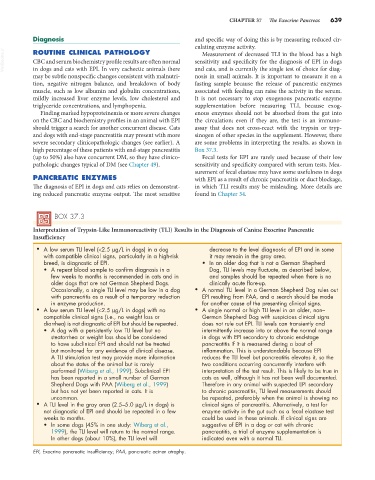Page 667 - Small Animal Internal Medicine, 6th Edition
P. 667
CHAPTER 37 The Exocrine Pancreas 639
Diagnosis and specific way of doing this is by measuring reduced cir-
culating enzyme activity.
VetBooks.ir CBC and serum biochemistry profile results are often normal sensitivity and specificity for the diagnosis of EPI in dogs
ROUTINE CLINICAL PATHOLOGY
Measurement of decreased TLI in the blood has a high
in dogs and cats with EPI. In very cachectic animals there
nosis in small animals. It is important to measure it on a
may be subtle nonspecific changes consistent with malnutri- and cats, and is currently the single test of choice for diag-
tion, negative nitrogen balance, and breakdown of body fasting sample because the release of pancreatic enzymes
muscle, such as low albumin and globulin concentrations, associated with feeding can raise the activity in the serum.
mildly increased liver enzyme levels, low cholesterol and It is not necessary to stop exogenous pancreatic enzyme
triglyceride concentrations, and lymphopenia. supplementation before measuring TLI, because exog-
Finding marked hypoproteinemia or more severe changes enous enzymes should not be absorbed from the gut into
on the CBC and biochemistry profiles in an animal with EPI the circulation; even if they are, the test is an immuno-
should trigger a search for another concurrent disease. Cats assay that does not cross-react with the trypsin or tryp-
and dogs with end-stage pancreatitis may present with more sinogen of other species in the supplement. However, there
severe secondary clinicopathologic changes (see earlier). A are some problems in interpreting the results, as shown in
high percentage of these patients with end-stage pancreatitis Box 37.3.
(up to 50%) also have concurrent DM, so they have clinico- Fecal tests for EPI are rarely used because of their low
pathologic changes typical of DM (see Chapter 49). sensitivity and specificity compared with serum tests. Mea-
surement of fecal elastase may have some usefulness in dogs
PANCREATIC ENZYMES with EPI as a result of chronic pancreatitis or duct blockage,
The diagnosis of EPI in dogs and cats relies on demonstrat- in which TLI results may be misleading. More details are
ing reduced pancreatic enzyme output. The most sensitive found in Chapter 34.
BOX 37.3
Interpretation of Trypsin-Like Immunoreactivity (TLI) Results in the Diagnosis of Canine Exocrine Pancreatic
Insufficiency
• A low serum TLI level (<2.5 µg/L in dogs) in a dog decrease to the level diagnostic of EPI and in some
with compatible clinical signs, particularly in a high-risk it may remain in the gray area.
breed, is diagnostic of EPI. • In an older dog that is not a German Shepherd
• A repeat blood sample to confirm diagnosis in a Dog, TLI levels may fluctuate, as described below,
few weeks to months is recommended in cats and in and samples should be repeated when there is no
older dogs that are not German Shepherd Dogs. clinically acute flare-up.
Occasionally, a single TLI level may be low in a dog • A normal TLI level in a German Shepherd Dog rules out
with pancreatitis as a result of a temporary reduction EPI resulting from PAA, and a search should be made
in enzyme production. for another cause of the presenting clinical signs.
• A low serum TLI level (<2.5 µg/L in dogs) with no • A single normal or high TLI level in an older, non–
compatible clinical signs (i.e., no weight loss or German Shepherd Dog with suspicious clinical signs
diarrhea) is not diagnostic of EPI but should be repeated. does not rule out EPI. TLI levels can transiently and
• A dog with a persistently low TLI level but no intermittently increase into or above the normal range
steatorrhea or weight loss should be considered in dogs with EPI secondary to chronic end-stage
to have subclinical EPI and should not be treated pancreatitis if it is measured during a bout of
but monitored for any evidence of clinical disease. inflammation. This is understandable because EPI
A TLI stimulation test may provide more information reduces the TLI level but pancreatitis elevates it, so the
about the status of the animal but is rarely two conditions occurring concurrently interfere with
performed (Wiberg et al., 1999). Subclinical EPI interpretation of the test result. This is likely to be true in
has been reported in a small number of German cats as well, although it has not been well documented.
Shepherd Dogs with PAA (Wiberg et al., 1999) Therefore in any animal with suspected EPI secondary
but has not yet been reported in cats. It is to chronic pancreatitis, TLI level measurements should
uncommon. be repeated, preferably when the animal is showing no
• A TLI level in the gray area (2.5–5.0 µg/L in dogs) is clinical signs of pancreatitis. Alternatively, a test for
not diagnostic of EPI and should be repeated in a few enzyme activity in the gut such as a fecal elastase test
weeks to months. could be used in these animals. If clinical signs are
• In some dogs (45% in one study: Wiberg et al., suggestive of EPI in a dog or cat with chronic
1999), the TLI level will return to the normal range. pancreatitis, a trial of enzyme supplementation is
In other dogs (about 10%), the TLI level will indicated even with a normal TLI.
EPI, Exocrine pancreatic insufficiency; PAA, pancreatic acinar atrophy.

